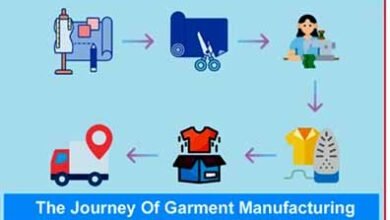
Towards Sustainable Garment Manufacturing:
AComprehensive Analysis, Challenges, and Solutions
|
Abstract: The fashion industry is a big player in global business, but it’s causing problems for the environment and society. This is mostly because of how clothes are made, which often hurts the planet and people in different communities. This research paper takes a close look at how clothes are made, figuring out what’s going wrong and why. It digs into how making clothes impacts the environment, how it affects people’s lives, and what it means for the economy. By really understanding these issues, the paper wants to make conversations about sustainable fashion richer and more useful. It also suggests new and smart ideas for making the fashion industry better for the planet and for people. Ultimately, it hopes to give people in the fashion world helpful ideas so they can start making real changes for the better. Introduction: The garment manufacturing industry is a sprawling network of processes involved in creating clothing and accessories. It encompasses everything from sourcing raw materials like fabrics and fibers to designing, cutting, sewing, and finishing garments. Garment manufacturing facilities vary widely in scale, from small workshops to large factories, and they operate in diverse geographic locations. The industry’s reach is extensive, with garments produced for various market segments, including luxury fashion, fast fashion, and niche markets. Importance of sustainability in garment production: Sustainability has become a pressing concern in the garment manufacturing industry due to its significant environmental and social impacts. The traditional model of garment production often prioritizes profit margins and efficiency over sustainability, leading to practices that harm the environment and exploit workers. Unsustainable practices in garment production contribute to issues such as water pollution, deforestation, greenhouse gas emissions, and labor abuses. Sustainable garment production involves minimizing the environmental footprint of the manufacturing process, ensuring fair treatment and safe working conditions for workers, and promoting ethical sourcing of materials. Environmental Impacts of Garment Manufacturing: Carbon emissions and climate change: · Garment manufacturing contributes significantly to carbon emissions throughout its lifecycle, including production, transportation, and disposal. · Energy-intensive processes such as textile production, dyeing, and finishing release greenhouse gases into the atmosphere, contributing to global warming and climate change. Water consumption and pollution: · Garment manufacturing is a water-intensive process, requiring large quantities of water for dyeing, washing, and finishing textiles. · The industry is a significant contributor to water pollution due to the discharge of untreated wastewater containing dyes, chemicals, and other pollutants into waterways. Chemical usage and hazardous waste: · Chemicals play a crucial role in various stages of garment manufacturing, including dyeing, bleaching, and finishing processes. · The accumulation of hazardous waste from garment manufacturing contributes to the pollution of landfills and presents challenges for safe disposal and management. Examples of environmental degradation caused by garment manufacturing include: · The pollution of rivers and waterways in textile-producing regions such as Bangladesh and India, where untreated wastewater from dyeing factories contaminates drinking water sources and harms aquatic ecosystems. · The destruction of rainforests in Southeast Asia and South America to make way for cotton plantations, leading to deforestation, habitat loss, and loss of biodiversity. Social Impacts of Garment Manufacturing: Labor rights abuses: · Garment manufacturing is notorious for labor rights abuses, including violations of basic human rights such as fair wages, safe working conditions, and freedom of association. · Workers in garment factories often face long hours, low wages, and lack of job security, with little to no recourse for addressing grievances. Exploitation of workers, particularly in developing countries: · The majority of garment manufacturing takes place in developing countries, where labor costs are lower and regulations may be laxly enforced. · Workers in these countries are often subjected to exploitative practices, including forced overtime, child labor, and unsafe working conditions. Health and safety hazards in garment factories: · Garment factories are often characterized by unsafe working conditions, including inadequate ventilation, poor lighting, and overcrowded spaces. · Workers are exposed to hazardous chemicals, dust, and noise levels that exceed safe limits, leading to respiratory problems, skin diseases, and hearing loss. Examples of social injustices within the industry: · Rana Plaza disaster: In 2013, the collapse of the Rana Plaza garment factory in Bangladesh killed over 1,100 workers and injured thousands more, highlighting the deadly consequences of unsafe working conditions and lack of regulation in the industry. · Sweatshop labor: Sweatshops, characterized by exploitative working conditions and low wages, are prevalent in many garment-producing countries, perpetuating cycles of poverty and inequality. Economic Impacts of Garment Manufacturing: Fast fashion and its implications for economies: · Fast fashion has revolutionized the fashion industry by offering trendy clothing at low prices with rapid turnover of styles. · Fast fashion boosts the economies of producing countries by creating jobs in garment factories, supporting ancillary industries like textiles and logistics, and generating export revenue. · Moreover, fast fashion’s reliance on cheap labor and resource-intensive production contributes to environmental degradation, which can harm economies dependent on agriculture and tourism. Dependency of developing countries on garment manufacturing: · Garment manufacturing provides jobs to millions of people, particularly women, contributing to poverty reduction and economic development. · However, dependence on this industry exposes countries to risks such as fluctuating global demand, labor market vulnerabilities, and competition from other low-cost manufacturing destinations. · Furthermore, the exploitation of cheap labor in developing countries can perpetuate inequalities and hinder progress towards sustainable economic growth. Economic viability of sustainable practices: · Sustainable practices in garment manufacturing, including ethical sourcing, environmentally friendly production methods, and fair labor practices, can have positive economic implications. · While initial investments in sustainability may be higher, they can lead to long-term cost savings through improved resource efficiency, reduced waste, and enhanced brand reputation. · Consumers are increasingly willing to pay a premium for sustainably produced clothing, creating market opportunities for brands that prioritize sustainability. Challenges in Achieving Sustainable Garment Manufacturing: 1. Lack of transparency in supply chains: · Many fashion brands and retailers have complex and opaque supply chains, making it difficult to trace the origins of materials and ensure ethical and environmentally responsible practices. · Without transparency, it is challenging for companies to identify and address issues such as labor exploitation, environmental degradation, and animal welfare concerns in their supply chains.
2. Pressure to meet consumer demand for fast fashion: · This pressure often leads to unsustainable production practices, including overproduction, excessive waste, and exploitation of labor. · Meeting fast fashion demands can incentivize brands and manufacturers to prioritize speed and cost efficiency over sustainability and ethical considerations. · Addressing this challenge requires a shift in consumer behavior towards more conscious and mindful consumption, as well as efforts by brands to educate and empower consumers to make sustainable choices. 3. Resistance from traditional manufacturing practices: · Many manufacturers rely on outdated technologies and processes that prioritize efficiency and cost savings over environmental and social responsibility. · Resistance to change can also stem from cultural norms, entrenched power dynamics, and economic incentives that prioritize short-term profits over long-term sustainability. · Overcoming resistance to sustainable practices requires strong leadership, investment in innovation, and incentives for adopting more sustainable technologies and processes. 4. Economic barriers to implementing sustainable technologies: · Many fashion brands and manufacturers, particularly smaller companies and those operating in developing countries, may lack the financial resources or incentives to invest in sustainability. · Economic barriers can include the cost of renewable energy sources, sustainable materials, and eco-friendly production processes, as well as the expenses associated with training and retooling existing infrastructure. · Addressing economic barriers requires innovative financing mechanisms, incentives for sustainable investment, and collaboration between public and private sectors to create a supportive environment for sustainable innovation. Solutions for Sustainable Garment Manufacturing: 1. Adoption of circular economy principles: · Transitioning to a circular economy model can help mitigate the environmental impact of garment manufacturing by minimizing waste and maximizing resource efficiency. · Circular economy principles emphasize reducing, reusing, and recycling materials throughout the product lifecycle, thereby reducing the reliance on virgin resources and minimizing environmental footprint. · Strategies such as designing for durability, repairability, and recyclability can extend the lifespan of garments and promote a more sustainable approach to consumption. 2. Investment in sustainable materials and technologies: · Investing in sustainable materials, such as organic cotton, recycled polyester, and eco-friendly dyes, can help reduce the environmental footprint of garment manufacturing. · Advancements in technology, such as water-saving dyeing techniques, energy-efficient production processes, and digital printing methods, can also contribute to sustainability by reducing resource consumption and pollution. · By incorporating sustainable materials and technologies into their operations, fashion brands and manufacturers can improve the environmental performance of their products while meeting consumer demand for eco-friendly options. 3. Transparency and traceability in supply chains: · Enhancing transparency and traceability in supply chains is essential for promoting accountability and ensuring ethical and sustainable practices throughout the garment manufacturing process. · Implementing traceability systems, such as blockchain technology, can enable brands and consumers to track the journey of garments from raw materials to finished products, thereby increasing transparency and accountability. · By disclosing information about suppliers, production methods, and environmental and social impact assessments, fashion brands can empower consumers to make informed purchasing decisions and drive demand for sustainable products. 4. Policy interventions and regulatory frameworks: · Governments play a crucial role in promoting sustainable garment manufacturing through policy interventions and regulatory frameworks that incentivize and enforce environmental and social standards. · Policy measures such as eco-labeling schemes, tax incentives for sustainable practices, and regulations on waste management and pollution control can encourage industry-wide adoption of sustainability initiatives. · By setting clear standards, monitoring compliance, and enforcing penalties for non-compliance, governments can create a level playing field for businesses and drive industry-wide improvements in environmental and social performance. Case Studies of Sustainable Garment Manufacturing Initiatives: 1. Patagonia: A pioneer in sustainable apparel: · Patagonia is widely recognized as a leader in sustainable apparel, known for its commitment to environmental stewardship and social responsibility. · The company prioritizes sustainability across its operations, from sourcing eco-friendly materials to reducing waste and promoting fair labor practices. · Patagonia has implemented innovative initiatives such as the “Worn Wear” program, which encourages customers to repair and reuse their clothing, extending the lifespan of garments and reducing the need for new production. · Additionally, Patagonia invests in renewable energy, offsets its carbon footprint, and advocates for environmental conservation through initiatives like the “1% for the Planet” program, where it donates a portion of its sales to environmental organizations. · By integrating sustainability into its business model and engaging with stakeholders, Patagonia demonstrates how companies can align profit with purpose and drive positive change in the fashion industry. 2. Eileen Fisher: Commitment to social and environmental responsibility: · Eileen Fisher is committed to sustainability and social responsibility, with a focus on transparency, ethical sourcing, and supply chain traceability. · The company emphasizes the use of organic and recycled materials in its clothing, as well as responsible manufacturing practices that minimize waste and pollution. · Eileen Fisher has established initiatives such as the “Vision 2020” program, which sets ambitious sustainability goals, including achieving carbon neutrality and zero waste by 2020. · Additionally, the company promotes fair labor practices and supports initiatives to empower women in the garment industry, both domestically and internationally. · Through its commitment to sustainability and social responsibility, Eileen Fisher sets an example for the fashion industry and demonstrates the importance of ethical business practices. 3. H&M: Efforts towards circular fashion and recycling initiatives: · H&M has made commitments to sustainability and circular fashion, aiming to minimize waste and maximize resource efficiency throughout its supply chain. · The company offers clothing recycling programs in its stores, where customers can donate old garments for recycling or reuse, promoting a circular approach to fashion. · H&M has also introduced sustainable collections made from recycled materials, such as the “Conscious Collection,” which features garments made from organic cotton, recycled polyester, and other eco-friendly fibers. · Additionally, H&M is investing in innovative technologies and partnerships to drive circularity in fashion, such as textile recycling and closed-loop manufacturing processes. · By embracing circular fashion principles and investing in recycling initiatives, H&M demonstrates its commitment to sustainability and its efforts to transform the fashion industry towards a more sustainable future. Conclusion: The exploration of garment manufacturing has revealed several critical findings. Firstly, the industry significantly impacts the environment, with activities such as carbon emissions, water pollution, and deforestation contributing to climate change and biodiversity loss. Secondly, social injustices, including labor exploitation and gender inequality, prevail within the industry, particularly in developing countries. Lastly, economically, fast fashion and reliance on garment manufacturing create challenges such as instability and barriers to sustainability. Importance of Transitioning Towards Sustainable Garment Manufacturing: Transitioning towards sustainable practices is imperative due to these findings. Sustainable approaches offer solutions to mitigate environmental degradation, promote fair labor practices, and foster economic resilience. By reducing resource consumption, minimizing waste, and prioritizing ethical production, the industry can address its negative impacts and pave the way for a more sustainable future. Call to Action for Industry Stakeholders to Embrace Sustainability: Industry stakeholders must take decisive action to embrace sustainability. Brands and manufacturers should prioritize transparency, invest in innovation, and adopt sustainable practices throughout the supply chain. Consumers play a crucial role by demanding ethically produced products and supporting brands that prioritize sustainability. Governments and NGOs should enact and enforce regulations that incentivize responsible business practices and support initiatives driving positive change. Future Directions for Research and Implementation Efforts: Moving forward, research and implementation efforts should focus on advancing sustainable technologies, fostering collaboration among stakeholders, and raising awareness about sustainability. Investing in research and development, facilitating partnerships, and educating stakeholders will be essential in driving industry-wide change and scaling up sustainable solutions. By embracing sustainability as a guiding principle and working together towards common goals, the fashion industry can lead the way towards a more sustainable and equitable future. References: https://apparelcoalition.org/sustainable-fashion/
https://www.weforum.org/agenda/2020/01/environmental-cost-of-fast-fashion/ https://unece.org/garment-manufacturing-and-sustainable-development-goals
Research By:- Chandan Kumar(BFT/21/506) Guided By:- Ms. Nilima Regina Topno
Note:- This has not been edited |




